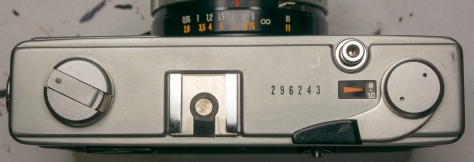So next step, even though I didn’t have to, is to open the top of the Olypus to clean the rangefinder.
Note: for horizontal adjustments to the rangefinder patch you do not have to take the top cover off. Open the film back and you will see a screw in the top middle of the film plane. Unscrew this to reveal a smaller recessed screw. Turn this to adjust.

Use the spanner wrench to unscrew the cap on the winding arm, and then take the parts off. Open the film back and jam the rewind, then you can unscrew the rewind knob.

You will see in the above image that the top of the camera has scratches from the winding arm. Due to the cover securing nut coming loose the winding arm was not sitting high enough.
Using the spanner wrench again you can unscrew both sides before you can pull off the cover. Note that there is a wire that connects to the hot shoe, so try not to yank too hard.

The rangefinder area is covered with black paper. You will also figure out if the spotmeter button is broken. In my case the plastic was broken, but there is enough of it to keep the button from falling into the camera.

Carefully pull off the paper. Now you can clean the insides.
I did not fiddle around with figuring out what screw adjusts the vertical alignment of the rangefinder patch … but it could be the circular knurled black plastic thing in the middle lens (some others have mentioned the recessed screw between the diodes, but it is said that is not correct).

 As I swore about before … the first thing to remove is the nameplate. On this particular version the nameplate is glued on … you might find a model that has this as a threaded ring, so check before spending the next hour trying to get it off.
As I swore about before … the first thing to remove is the nameplate. On this particular version the nameplate is glued on … you might find a model that has this as a threaded ring, so check before spending the next hour trying to get it off.





 This image shows it after I screwed it back on.
This image shows it after I screwed it back on. The SP in the model name stands for SPot meter (OK, that’s just my guess) … yes, this camera has spot metering !! and centre weight. The SPn and UC versions are the same camera with just minor changes.
The SP in the model name stands for SPot meter (OK, that’s just my guess) … yes, this camera has spot metering !! and centre weight. The SPn and UC versions are the same camera with just minor changes.